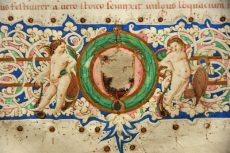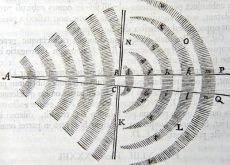- About
- Visiting
- What’s On
- Venue hire
- Catalogues
- Collections
- 101 Treasures of Chetham’s
- Digital Resources
- The Flowers of Histories
- A Book of Hours from France
- The Manchester Scrapbook
- Thomas Barritt of Manchester
- Art Treasures Examiner of 1857
- Manchester Association for Constitutional Order
- The North Western Museum of Science and Industry: Some Reminiscences by Richard Hills
- Criminal Manchester
- The Cup of Destiny
- Athenaeum Souvenir
- Middle English Manuscripts
- Manchester and Liverpool of Today
- Hollingworth’s Mancuniensis
- Memoir of Cecil Wray
- William Seward’s Diary
- The Anti-Monopolist
- Fishwick’s History of Rochdale
- Knyvett’s Defence of this Realm
- Tractatus de Nigromantia
- Axon Ballads
- Printed Books & Ephemera
- Archives & Manuscripts
- Prints and Photographs
- Blog
- Support us
John Dee
Material associated with John Dee (1527-1608)

John Dee was appointed warden of the college at Manchester in 1595, and remains one of the most famous figures associated with the establishment. Dee, who developed a reputation as an astrologer, alchemist and occultist, was also an important renaissance scientist, mathematician and philosopher.
By the time he took up the position of warden at the advanced age of sixty-eight, Dee’s reputation as a scholar and as a student of the occult was well established, and although he did not welcome the move to Manchester, he thought that it would at least provide him with a steady income and the chance to pursue his studies in peace. His hopes were immediately dashed. Throughout his stay he was beset with money problems and his relations with the fellows of the Collegiate Church were marked by antagonism that bordered on hatred. In 1605 he left Manchester weary of the struggle and returned home to Mortlake where he spent the remaining years of his life.
John Dee’s library was one of the largest and greatest of his day and Chetham’s has five books which once belonged to Dee. This copy (above and immediately below) of a work by the great sixteenth-century Swiss physician and naturalist Conrad Gesner is signed ‘Joannes Dee 1556’ on the title page. It is copiously annotated throughout including some marginal drawings of figures and apparatus. It is likely that the book stayed in Manchester after Dee’s departure in 1605.
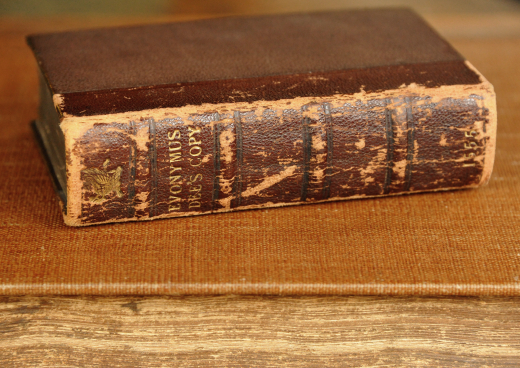
Conrad Gesner, De remediis secretis (A book of little known remedies)
Printed in Lyons by Balthazar Arnolletus, 1555.
Dee began collecting books at an early age. The work of history shown below – attributed to Arrian, Hanno, Plutarch and Strabo – was purchased by John Dee in 1547 at the age of twenty and annotated by him in Greek and Latin.
Arriani & Hannonis periplus. Plutarchus de fluminibus & montibus. Strabonis epitome Printed in Basel by Froben in 1533
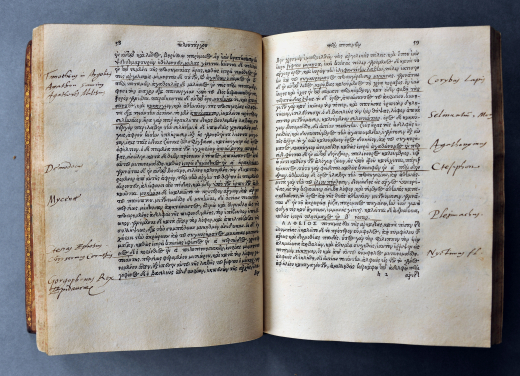
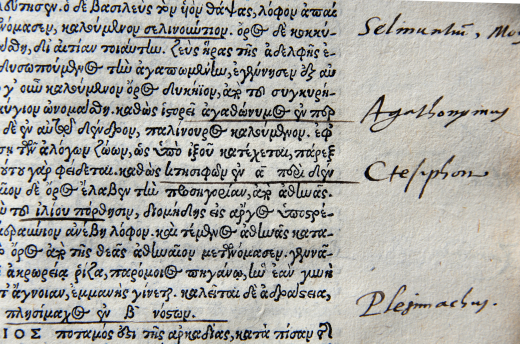
One of the tasks that Dee set himself as warden was to sort out the boundaries of the parish and manor of Manchester. In 1596 Christopher Saxton, who had produced the first national atlas of England and Wales, was employed to carry out a survey of Manchester. Unfortunately, no copies of the survey have survived. The parish boundary was a sensitive issue and resulted in a great deal of opposition from local landowners and clergy. In the letter below, Dee writes to William Langley, Rector of Prestwich, to solicit his assistance:
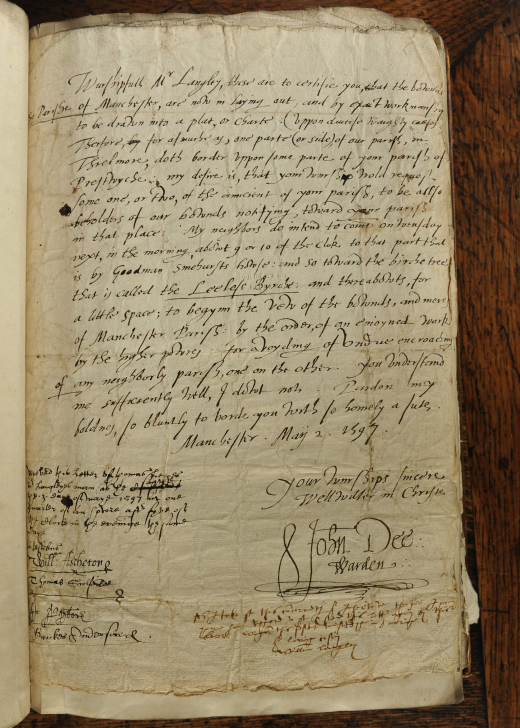
Wurshipfull Mr Langley, these are to certifie you, that the bownds of the Parishe of Manchester, are now in Laying out, and by exact workmanship to be drawn into a plat, or charte: Uppon diverse waighty causes, therfore, for as muche as, one parte (or side) of our parish, in Thielmore, doth border uppon some parte of your parish of Prestwyche: my desire is, that your wurship wold request some one, or two, of the auncient of your parish, to be allso beholders of our bownds notifying, toward your parish in that place: My neighbors do intend to come on Wensday next in the morning, abowt 9 or 10 of the clock so that part that is by Goodman Smehurst’s howse: and so toward the birche tree, that is called the Leeless Byrche; and thereabowts, for a little space; to begynn the vew of the bownds and meres of Manchester Parish: by the order, of an enioyned work by the higher powres: for avoyding of undue encroaching of any neighborly parish, one on the other. You understand me sufficiently well, I dowt not. Pardon my boldness, so bluntly to borde you with so homely a sute.
Manchester Maii 2 1597
Your wurships sincere
Wellwiller in Christe
John Dee
Warden
Letter from John Dee to William Langley, Rector of Prestwich, 2 May 1597
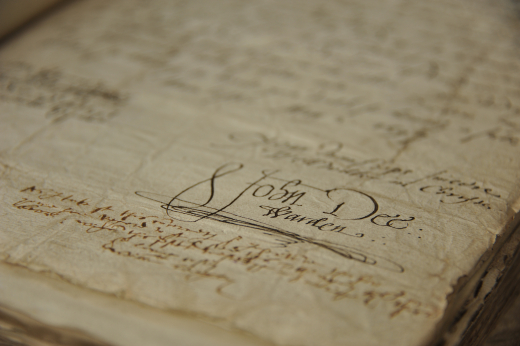
In 1841 the novelist Harrison Ainsworth published the novel Guy Fawkes, or The Gunpowder Treason: An Historical Romance, in which Dee, Fawkes and Humphrey Chetham are described meeting in the warden’s room (now the Library Reading Room). There is no evidence for this encounter but it is possible that the young Humphrey Chetham knew John Dee. Dee borrowed money from Humphrey’s older brother Edmund who was master of the Grammar School from 1597 to 1602.
This illustration by George Cruikshank from the book shows Dee’s meeting with Guy Fawkes:
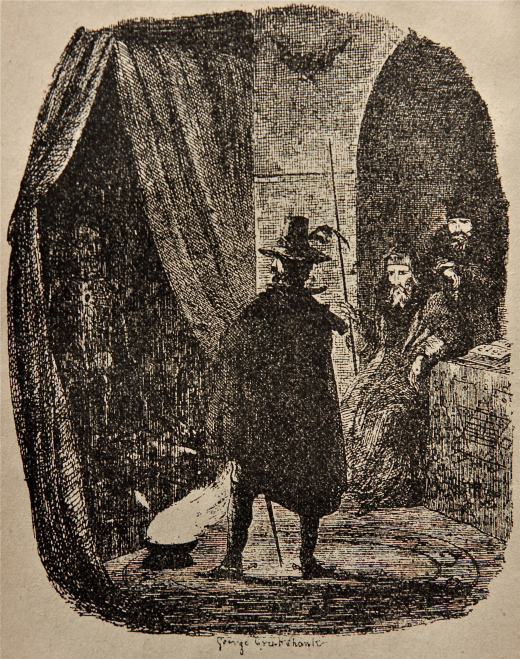
‘Doctor Dee in conjunction with his seer, Edward Kelley, exhibiting his magical skill to Guy Fawkes.’
William Harrison Ainsworth, Guy Fawkes or The Gunpowder Treason: An Historical Romance Illustrated by George Cruikshank
Printed in Manchester by Lewis’s, undated.
